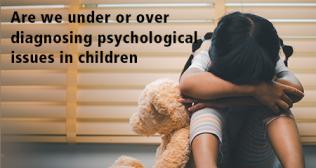
Mental Health and Behavioural Sciences
Adolescence: An Emotionally Challenging Time For Children
Dr. Samir Parikh Jan 19, 2015
 The phase of adolescence has widely been recognized as a critical period of rapid development, and which are likely to have a significant impact on both the physical as well as mental health of the adolescents.The transition between childhood and adulthood comes with many challenges alongside their physical, cognitive, as well as social development.
Common issues of adolescence
As children reach the higher years of their schooling, they are eager to have their taste of freedom, as their need for independence begins to thrive. They become increasingly self-centric in their views, and hence teenage is the time of greatest conflicts of interests and problems with authority figures. In their quest for fulfilling their demands, they begin to almost seem rebellious, and a common teenage mantra is “But why? This is not fair!” etc.
This is the time when friends seem to become more important than ever, as the influence of peers is at its peak for the youth. This is the time for them to become experimental, and test their limits, and often they might not be able to understand the consequences of their actions at the time. Hence the youth are likely to indulge in risk taking behaviours, and are prone to abuse substances.
Besides the influence of the peers, the media is another factor that has a major impact especially on the children and adolescents today. Research has shown that watching media with aggression, whether in the form of movies, cartoons, shows, news, or reality shows, is strongly linked to an increase in aggressive behaviour in children. As the youth extensively play violent videogames, this could desensitize them towards violence and pain. And aggression is just one of the concerns regarding the passive influence of media. The media has always known to define what is desirable and in vogue, thriving on stereotypical notions, and thereby planting unrealistic images and ideas in the minds of our youth.
Since the youth are typically concerned about their body image, as they explore attractions and intimacy, they often end up dealing with identity and role confusions as well. Moreover, in the sway of their peer influences, most adolescents develop the tendency to compare themselves with others, and this could serve as a major factor being responsible for a negative view of themselves.
Mental health of the youth
Depression is one of the most common mental health related illnesses to affect a person and is found in people of all ages including children and adolescents, with about 11 percent adolescents having had a depressive disorder by age 18 (NIMH). Suicide was the second leading cause of death among 15-29 year olds globally in 2012 and this trend continues to rise even today (WHO). Moreover, it is estimated by the Centres for Disease Control and Prevention (CDC) that at least 25 attempts are made for every completed teen suicide. According to the NIMH, eating disorders affect 2.7% of 13 to 17 year olds worldwide (2010). Adolescent substance use has become one of the major areas of concern in India, with an estimate of 50% boys having tried at least one substance by the ninth grade (1991). Moreover, according to a recent study in India, easy availability and relief from tension were the most frequent reasons reported for the continuation of substance use, with media being stated as the most frequent source of information (Tsering et al, 2010).
Considering the physical and emotional changes that occur in adolescence, it is natural for these emotions and feelings to be experienced very intensely, thereby leading to a vulnerability towards impacting their mental health. When teenagers go through difficult emotions such as loneliness or extremely stressful situations that have grave ramifications on their self-esteem and self-concept, they can be driven to self-harm or even suicide.
In the light of the glamorization promoted by the media, it’s no wonder that body image concerns and eating disorders are becoming prominent in the youth today. It is not surprising, as most of us, especially youngsters, have begun to define and value themselves and others based on the brands they wear and the model of mobile phones that they carry. Such ideologies are likely to create feelings of inadequacy and relative deprivation, thereby creating a sense of discrepancy between one’s perceived as well as ideal self.
Teens are given to be experimental with many risk taking behaviours including the use and abuse of drugs and alcohol. More often than not, addiction sneaks up on the adolescent with a gradual increase in the use of substances as they begin to fulfil a valuable need in the eyes of the user – this need could be anything from mood elevation to pain relief. Some teenagers may turn to substances simply out of curiosity or even as a faulty coping mechanism to deal with their feelings of loneliness, depression, stress or anxiety, or to cope with family related problems and stressors.
Suggestions
Despite an increasing prevalence, mental disorders in adolescents are mostly under-reported, and hence adequate and timely help is not always able to reach those who need it, particularly in the underprivileged segments of the society. A major hindrance to the timely treatment of the condition is also the lack of awareness and understanding and knowledge which could facilitate timely identification.
The need of the hour is to encourage education about the mental health issues surrounding the youth of the country, in order to enable a timely identification. This is especially important as many times such issues are neglected as being a typical by-product of adolescence itself. It is important to recognize these as diagnosable disorders which can be effectively treated, and which could have adverse long-term consequences if neglected. Besides identification, we must be open to seeking help. It is important to help our society overcome the stigma attached to mental health, and to encourage children and adolescents to be able to reach out to trained professionals.
Moreover, it is vital to bring about a change in the way our society thinks about the youth and their mental health. Engagement with parents, schools as well as communities should be promoted to empower them for the timely identification as well as encourage resilience, emotional regulation, social skills, and healthy coping mechanisms for the youth. Such an approach could not only help preventing mental health issues but also improve the psychological well-being of children and adolescents.
The phase of adolescence has widely been recognized as a critical period of rapid development, and which are likely to have a significant impact on both the physical as well as mental health of the adolescents.The transition between childhood and adulthood comes with many challenges alongside their physical, cognitive, as well as social development.
Common issues of adolescence
As children reach the higher years of their schooling, they are eager to have their taste of freedom, as their need for independence begins to thrive. They become increasingly self-centric in their views, and hence teenage is the time of greatest conflicts of interests and problems with authority figures. In their quest for fulfilling their demands, they begin to almost seem rebellious, and a common teenage mantra is “But why? This is not fair!” etc.
This is the time when friends seem to become more important than ever, as the influence of peers is at its peak for the youth. This is the time for them to become experimental, and test their limits, and often they might not be able to understand the consequences of their actions at the time. Hence the youth are likely to indulge in risk taking behaviours, and are prone to abuse substances.
Besides the influence of the peers, the media is another factor that has a major impact especially on the children and adolescents today. Research has shown that watching media with aggression, whether in the form of movies, cartoons, shows, news, or reality shows, is strongly linked to an increase in aggressive behaviour in children. As the youth extensively play violent videogames, this could desensitize them towards violence and pain. And aggression is just one of the concerns regarding the passive influence of media. The media has always known to define what is desirable and in vogue, thriving on stereotypical notions, and thereby planting unrealistic images and ideas in the minds of our youth.
Since the youth are typically concerned about their body image, as they explore attractions and intimacy, they often end up dealing with identity and role confusions as well. Moreover, in the sway of their peer influences, most adolescents develop the tendency to compare themselves with others, and this could serve as a major factor being responsible for a negative view of themselves.
Mental health of the youth
Depression is one of the most common mental health related illnesses to affect a person and is found in people of all ages including children and adolescents, with about 11 percent adolescents having had a depressive disorder by age 18 (NIMH). Suicide was the second leading cause of death among 15-29 year olds globally in 2012 and this trend continues to rise even today (WHO). Moreover, it is estimated by the Centres for Disease Control and Prevention (CDC) that at least 25 attempts are made for every completed teen suicide. According to the NIMH, eating disorders affect 2.7% of 13 to 17 year olds worldwide (2010). Adolescent substance use has become one of the major areas of concern in India, with an estimate of 50% boys having tried at least one substance by the ninth grade (1991). Moreover, according to a recent study in India, easy availability and relief from tension were the most frequent reasons reported for the continuation of substance use, with media being stated as the most frequent source of information (Tsering et al, 2010).
Considering the physical and emotional changes that occur in adolescence, it is natural for these emotions and feelings to be experienced very intensely, thereby leading to a vulnerability towards impacting their mental health. When teenagers go through difficult emotions such as loneliness or extremely stressful situations that have grave ramifications on their self-esteem and self-concept, they can be driven to self-harm or even suicide.
In the light of the glamorization promoted by the media, it’s no wonder that body image concerns and eating disorders are becoming prominent in the youth today. It is not surprising, as most of us, especially youngsters, have begun to define and value themselves and others based on the brands they wear and the model of mobile phones that they carry. Such ideologies are likely to create feelings of inadequacy and relative deprivation, thereby creating a sense of discrepancy between one’s perceived as well as ideal self.
Teens are given to be experimental with many risk taking behaviours including the use and abuse of drugs and alcohol. More often than not, addiction sneaks up on the adolescent with a gradual increase in the use of substances as they begin to fulfil a valuable need in the eyes of the user – this need could be anything from mood elevation to pain relief. Some teenagers may turn to substances simply out of curiosity or even as a faulty coping mechanism to deal with their feelings of loneliness, depression, stress or anxiety, or to cope with family related problems and stressors.
Suggestions
Despite an increasing prevalence, mental disorders in adolescents are mostly under-reported, and hence adequate and timely help is not always able to reach those who need it, particularly in the underprivileged segments of the society. A major hindrance to the timely treatment of the condition is also the lack of awareness and understanding and knowledge which could facilitate timely identification.
The need of the hour is to encourage education about the mental health issues surrounding the youth of the country, in order to enable a timely identification. This is especially important as many times such issues are neglected as being a typical by-product of adolescence itself. It is important to recognize these as diagnosable disorders which can be effectively treated, and which could have adverse long-term consequences if neglected. Besides identification, we must be open to seeking help. It is important to help our society overcome the stigma attached to mental health, and to encourage children and adolescents to be able to reach out to trained professionals.
Moreover, it is vital to bring about a change in the way our society thinks about the youth and their mental health. Engagement with parents, schools as well as communities should be promoted to empower them for the timely identification as well as encourage resilience, emotional regulation, social skills, and healthy coping mechanisms for the youth. Such an approach could not only help preventing mental health issues but also improve the psychological well-being of children and adolescents. Categories
Clear allMeet the doctor

Dr. Samir Parikh
CONSULTANT MENTAL HEALTH & BEHAVIOURAL SCIENCES | Fortis Shalimar Bagh
- Mental Health and Behavioural Sciences | Mental Health and Behavioural Sciences | Psychiatry | Clinical Psychology
-
21 Years
-
900



















